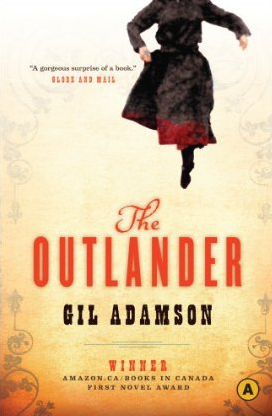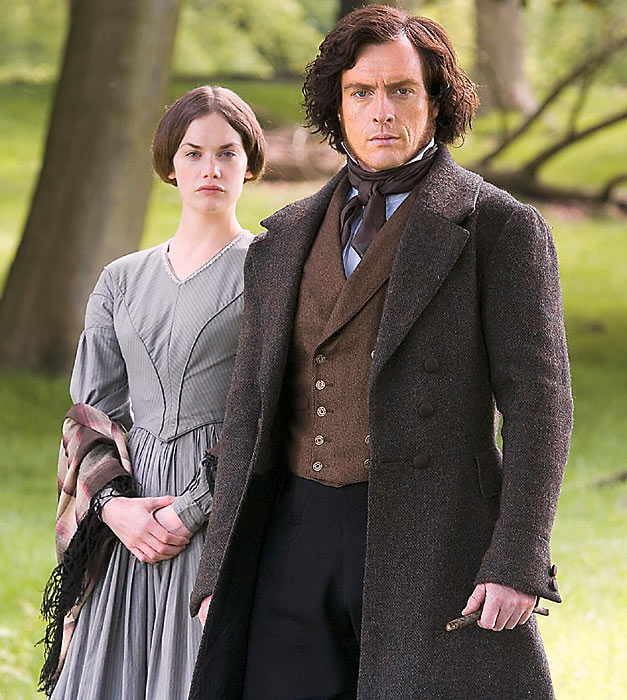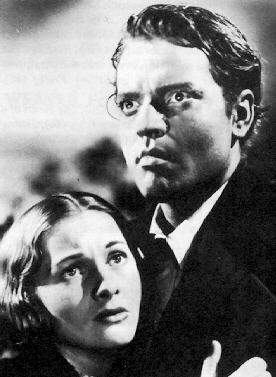Glen Huser's Movie and Book Picks for April, 2011
My Movie Pick: Jane Eyre

I’m a huge fan of nineteenth century novels – and their film incarnations — so, needless to say, I was at one of the first screenings in Vancouver of the latest version of Jane Eyre. Twenty-two-year-old Mia Wasikowska is the right age for portraying the young governess and I was impressed with the quiet intensity she brought to the role. The Eyre in Bronte’s novel is a plain Jane, but a moviemaker still needs to communicate the beyond-the-surface fascination that Edward Rochester finds in this latest addition to his staff at Thornfield.
And he’s made a good choice in casting Michael Fassbender as the troubled master of the Yorkshire mansion. Fassbender has tackled such varied and extraordinary characterizations as Dracula and Bobby Sands (in the film Hunger), and – for my money – he offers us a similar kind of edginess to his depiction of Edward Rochester. He’s a better Rochester than Orson Welles in the 1944 film rendition, I think. Welles seems just a little too American somehow for the part whereas Fassbender brings a sense of the well-heeled British man of privilege to the role along with sturm und drang of a character who has his mad wife locked up in an attic tower.
While this new version of the classic has a number of advantages over the 1944 film – consider the sweeping landscapes which capture the moors in wonderful muted colours caught seeping from beneath retreating storm clouds – the Welles picture retains much to recommend it. The screenplay is very similar – almost word for word in places – to the new version, except that it deletes the whole St. John Rivers sub-plot, but I like the straightforwardness of the older screenplay. The flashbacks in the new picture seem to tangle a plot that needs no tangling. And, in the 1944 film, we have Joan Fontaine’s quiet, almost haunted voice reading the beginning lines as a voice-over. Fontaine was 26 when she played Jane Eyre, and she – like Wasikowska – had an innate sense of how best to underplay a scene, and how to let her eyes do the telling.
Considering the Welles film (it was actually directed by Robert Stevenson but Welles’ influence is apparent throughout), we need to acknowledge that the entire beginning is much better than this latest remake. Credit must be given to the talented child actor, Peggy Ann Garner, who brings an intensity to the young Jane that segues perfectly into the woman Eyre becomes. It’s a beautiful performance, a prelude to Garner’s more famous role of Francie in Elia Kazan’s A Tree Grows in Brooklyn the following year. Other child actors showcased in the film are Margaret O’Brien as Rochester’s ward , Adele, and a brief (uncredited) appearance by Elizabeth Taylor in one of her first film roles as Jane’s doomed friend, Helen Burns, in the dreadful charity school, Lowood.
Now, if you’re really into comparing different versions of Bronte’s story, you should probably have a look at Franco Zeffirelli’s 1996 version (starring William Hurt as Rochester and Charlotte Gainsbourg as Jane – or the 1970 Susannah York—George C. Scott pairing). But, if you’re like me, placing the black-and-white gothic retelling from the 1940s with its studio sets and spooky (often bombastic) Bernard Herrmann score and a context of film noir and horror flicks next to a 21st-century recreation with its widescreen panoramas in colour and its lavish period detail, computer-generated effects, and delicate instrumental background music is not only a great deal of fun but a palatable study in film history.


My Book Pick: The Outlander
 My book pick for this month is a novel that follows the flight of a deranged woman across the foothills and mountains of the northwestern States into the southwestern territory of Canada at the turn of the last cen
My book pick for this month is a novel that follows the flight of a deranged woman across the foothills and mountains of the northwestern States into the southwestern territory of Canada at the turn of the last cen tury. Little in life has prepared Mary Boulton for a frontier existence as a teenage bride. Within a year, she watches the death of her sickly baby boy, observing her husband’s callous acceptance of this loss while he escapes from her grief into the arms of another woman. Mary is much better at wielding a needle than a rifle, but she manages to shoot John Boulton in the leg and then proceeds to arrange herself in widow’s garb after he bleeds to death.
tury. Little in life has prepared Mary Boulton for a frontier existence as a teenage bride. Within a year, she watches the death of her sickly baby boy, observing her husband’s callous acceptance of this loss while he escapes from her grief into the arms of another woman. Mary is much better at wielding a needle than a rifle, but she manages to shoot John Boulton in the leg and then proceeds to arrange herself in widow’s garb after he bleeds to death.
The narrative actually begins with her fleeing on foot from her twin redheaded brothers-in-law who are determined to capture her and see her hanged. And right from the beginning, we are aware that Adamson has a rich gift with words: It was night, and dogs came howling through the trees, unleashed and howling. They burst from the cover of the woods and their shadows swam across a moonlit field…The girl scrambled through ditchwater and bulrushes, desperate to erase her scent. For a perilous moment she dared to stop running, to stand motionless, listening, holding her dark skirts out of the water. In the moonlight, her beautiful face was hollow as a mask, eyes like holes above the smooth cheeks.
Mary Boulton turns out to be wily in her desperation. Briefly she accepts the sanctuary of an eccentric well-heeled townswoman, but when the brothers hove onto the scene, she makes off with stolen boots and provisions on a horse from her benefactress’s stable. The journey will take her into the mountains where she nearly dies from starvation before a mountain man – a thief himself, on the run from forest rangers — finds her. William Moreland has become known as “The Ridgerunner” and, as he shows the runaway many of the tricks for surviving in the wilderness, the two fall in love.
Without giving away too much of the story, we soon find Mary on her own and on the run again, trekking – with the aid of a somewhat surly Indian – to the small mining town of Frank, Alberta. Here she is an outlander among other misfits and miners – a preacher who boxes his parishioners into submission, a dwarf who runs a general supply store (including such wares as liquor and laudanum), a gigantic Italian who has a still hidden out in the woods, and a family of eight brothers who steal horses and sell them.
As a story juggler, Adamson keeps many balls in play, building to the telling of the fateful night in 1903 when the face of Turtle Mountain crumbles and falls on the sleeping town. Something of a tour de force, I have to say. It’s a wild story with the span, in places, of a tall tale, capturing aspects of the frontier experience that were often tragic and bizarre. Adamson acknowledges a debt to a book that I have always found fascinating reading: Michael Lesy’s Wisconsin Death Trip, which meshes together a photographer’s archive (many of the pictures strange and haunting) with hair-raising newspaper clippings from the midwest in the 1890s.
The Outlander has won a raft of awards including the Amazon/Books in Canada First Novel Award and the Dashiell Hammett Award.





Hi, Enjoyed your reviews. Just wanted to let you know that the photo you have for Jane Eyre is incorrectly referenced. You have pictured Ruth Wilson and Toby Stephens, from another version of Jane Eyre.
Hey, Wiz — a sharp eye! Now I feel I need to track down the TV movie you’ve referenced and have a look at it. Ruth Wilson and Mia Wasikowska do look somewhat alike, I think. Michael Fassbinder and Toby Stephens — less so.
To my readers (and viewers) — apologies for the mismatch on this!